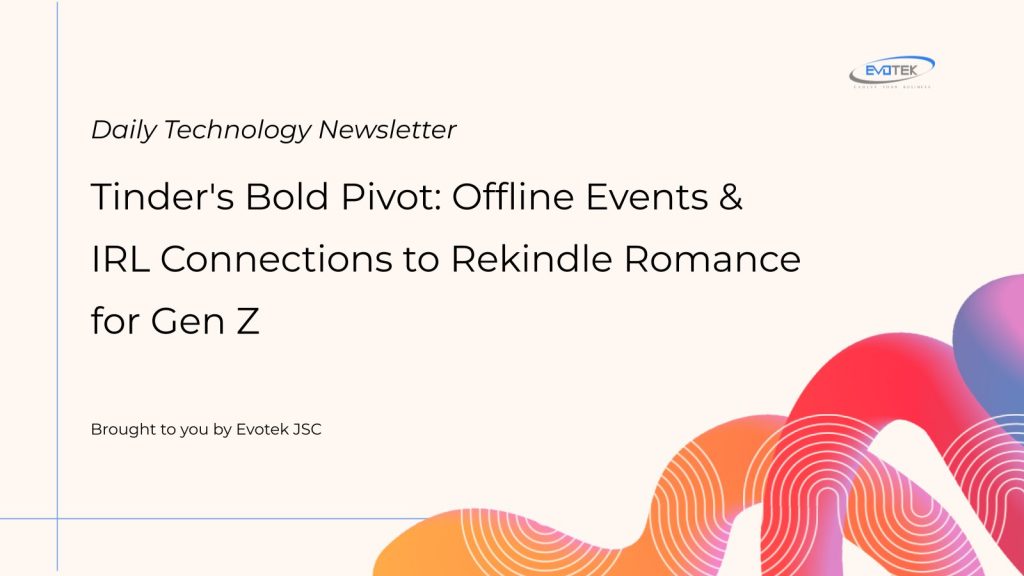A decade ago, Tinder revolutionized dating, making it effortless for singles to discover matches with a simple swipe. Today, as the digital dating landscape evolves, Tinder is fighting to maintain its allure, even if it means venturing beyond the screen and into the real world.
Last month, the dating app orchestrated a unique event, bringing UCLA students together offline. Instead of endless swiping, participants swayed on the dance floor at the Fowler Museum, grooving to DJ Disco Lines. This unexpected move saw students engaging face-to-face, smartphones held aloft not for profile browsing, but for recording the vibrant scene, including Disco Lines’ trending remix of Tinashe’s “No Broke Boys.”
From Digital Swipes to Real-World Sways: Tinder’s New Strategy
The West Hollywood-based company strategically partnered with DJ Disco Lines and college influencers, leveraging TikTok and Instagram to amplify the event and the app. Ahead of the show, Tinder encouraged downloads to reveal the event details, with Disco Lines himself miming the iconic “swipe right” motion in promotional videos.
Mark Kantor, Tinder’s head of product, explains this shift: “Gen Z wants to connect authentically. They believe in romance. They’re open to serendipity.” He emphasizes that younger daters seek more than just a photo-centric experience; they crave genuine connections beyond superficial profiles.
Addressing a Decline: Why Tinder is Changing Course
This pivot towards in-person engagement and new features comes as Tinder faces a significant dip in user numbers. In the third quarter of this year, the platform reported 9.2 million paying users, a 7% decrease year-over-year, alongside a 3% revenue drop to $491 million. While a free version exists, premium features (like seeing who likes your profile or boosting visibility) have seen less uptake.
Despite remaining the world’s most popular dating app, its monthly active users in the U.S. have fallen to roughly 11 million this quarter, down from 18 million in early 2022, according to Sensor Tower data.
A new leadership team, including CEO Spencer Rascoff (who also helms parent company Match Group) appointed in July, is spearheading this reinvention. Their bet is that fresh features will reignite Tinder’s spark and reclaim its top position.
Innovating for the Future: New Features & AI Integration
Tinder’s recent releases include double date and college mode, allowing students to connect with peers at their own or nearby universities. The app is also testing “Chemistry,” an AI-powered feature that analyzes users’ camera rolls with their permission to better understand interests and personality. To combat catfishing and enhance trust, Tinder has begun requiring video selfies in several countries to verify user identity against profile pictures.
Kantor summarizes Tinder’s overarching goal: to make dating fun again. “Dating has become this thing that, for many people, has felt like work, and meeting people really needs to be fun,” he stated.
The Dating App Dilemma: Fatigue and the Quest for Real Romance
Launched in 2012, Tinder fundamentally altered dating by simplifying profile browsing and matching. However, its convenience also fostered a “love-hate” relationship among users. Many flocked to it for casual encounters, but a significant portion now experiences “dating apocalypse” fatigue – a perceived decline in romance and commitment, fueled by the endless pursuit of the “perfect match” just a swipe away.
Twenty-seven-year-old actor Sam Nejad, known from “The Bachelorette,” noted, “For guys, specifically, from my experience, it’s purely a smashing app.” This perception often leaves users, particularly women, feeling that the app doesn’t cater to their desire for deeper connections.
Frustrated by a stream of gym selfies, “thirst traps,” scammers, and cliché “men holding fish” photos, many daters are seeking love offline – at running clubs, events, even unconventional places like Home Depot and Costco.
The Rise of Competitors and IRL Meet-Cutes
This user dissatisfaction has fueled the growth of Tinder’s competitors. Apps like Bumble, Hinge, and Grindr, along with Facebook Dating, now vie for users’ attention. Startups are even developing AI companions and advanced matching algorithms.
Cassidy Davis, tired of endless app-generated coffee dates, hosted “chaotic singles parties” in 2022, inviting friends to bring one person they met on an app. A viral TikTok led to monthly events across major cities. Davis, now engaged to a man she met at her first party (not through an app), believes in the power of real-life encounters. “The apps are still really useful, but a lot of people these days are looking for that rom-com, IRL meet-cute,” she said, acknowledging that her fiancé’s “profile wouldn’t have translated to the awesome person he is today.”
Tinder’s Enduring Edge and Future Vision
Despite the challenges, Tinder holds a significant competitive advantage: its vast user base and global recognition. It remains the go-to app for many embarking on their dating journey, explicitly aiming to facilitate all types of relationships, from open connections to lasting love or new friendships.
Match Group CEO Spencer Rascoff, a Harvard graduate who learned about Gen Z’s dating preferences directly from students, is confident in Tinder’s renewed direction. He estimates a massive untapped market of approximately 250 million single individuals worldwide who actively date but aren’t currently on dating apps. “We’ve clarified what Tinder stands for and who we’re building it for,” he affirmed.
UCLA student Sharlize True Trujillo, 21, who promoted Tinder’s Disco Lines event, echoed a common sentiment: “My friends and I would prefer to meet someone in person. But at this time, we meet way more people that are our type online.” This highlights the ongoing paradox for dating apps: while users crave real-world connections, the digital realm remains a powerful discovery tool.

 日本語
日本語 한국어
한국어 Tiếng Việt
Tiếng Việt 简体中文
简体中文